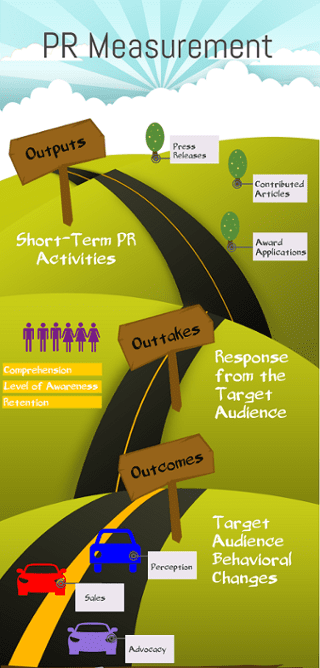Companies seeking to invest in PR for the first time often approach the process with a lack of understanding on how PR is measured. Corporations often look at the field with their marketing lenses on believing that an investment in PR will impact their bottom line immediately – but this thinking is significantly flawed. PR isn’t as easily quantifiable as marketing or advertising; it has immediate, short-term and long-term effects on a company’s profits.
The ideal PR measurement links an agency’s efforts with an organization’s key performance indicators (KPIs). This allows the agency to uncover what the company objectives are and formulate an effective PR strategy to determine how PR can be utilized to attain those objectives. The three Os in PR used to measure its impact are outputs, outtakes and outcomes. Let’s take a closer look.

Outputs
Outputs are the most basic form of measurement and it looks at short-term PR activities. PR outputs define what the agency produced and evaluates how well it did producing it. PR outputs include press releases, contributed articles, award applications, etc. By using this form of measurement, the agency can easily determine if there are any inefficiencies in the PR process. To determine PR outputs, the following questions should be asked:
1. What was produced?
2. Was it on time?
3. Was it within budget?
Outtakes
As the next level in measurement, outtakes focus on the response from the target audience. Outtakes measure who was reached with the PR message and the audience takeaway i.e. their level of awareness, comprehension and retention. One value of PR is to build awareness and outtakes allow both clients and their PR agency to determine how much traction and buzz was created around a PR activity. To determine PR outtakes, the following questions should be asked:
1. What’s the circulation numbers for the publication featuring the client?
2. How many views did the article receive?
3. What percentage of tweets about the company announcement were positive?
Outcomes
Outcomes are the mecca of PR and are also the most complex level of measurement as they occur in the long term. This level of measurement looks at the attitudinal and behavioral changes of the target audience as a result of PR efforts. As outcomes occur gradually, they require a greater buy-in from the client and additional resources as well. Outcomes highlight the greatest impact of PR on changes in perceptions, advocacy and ultimately sales. To determine PR outcomes, the following questions should be asked:
1. Who purchased the product?
2. Were any qualified leads generated over the quarter?
3. Were the objectives of the campaign met (e.g. did people stop littering)?
Trying to measure PR as you would any other field is like comparing apples and oranges – it just won’t work. But using the three Os in PR and relying on tools well used in other fields like Google Analytics and Salesforce, measuring PR is simplified. Making the connection between PR and KPIs allows corporations to measure what’s important and see how effective PR really is for a company.
>> Need help with PR measurement? Turn to the pros at an experienced digital PR agency like PAN.


